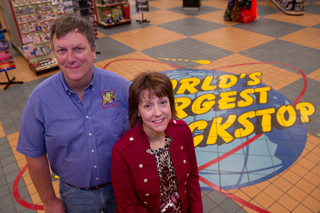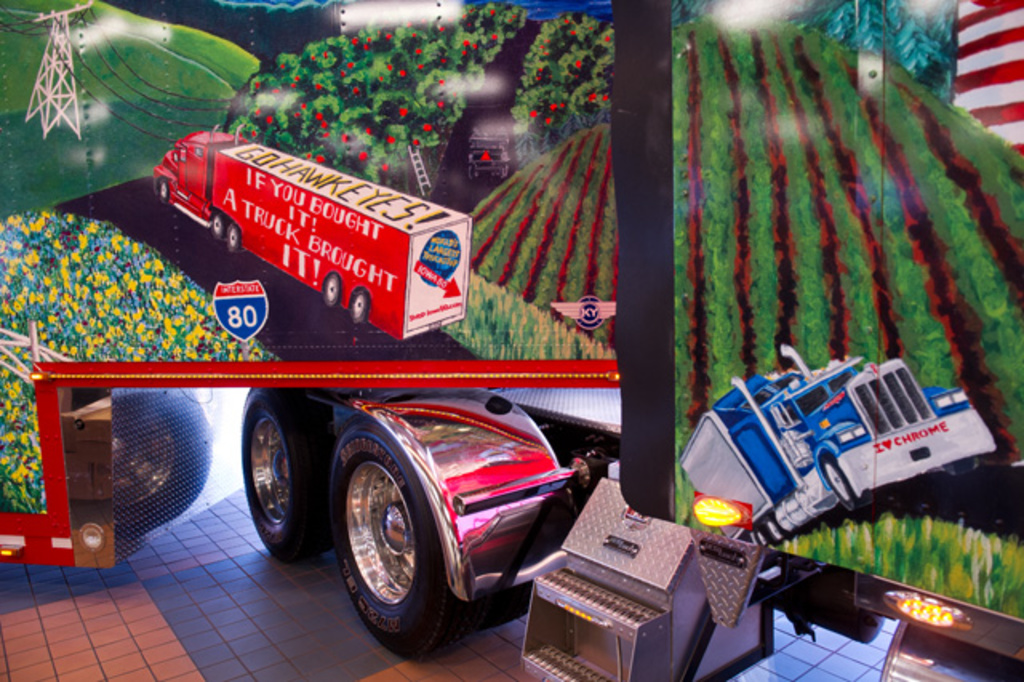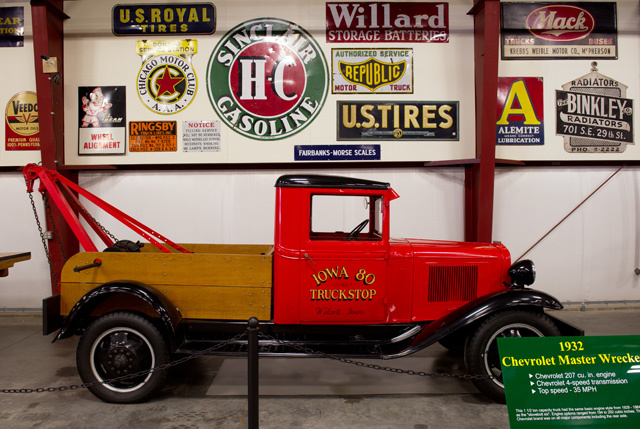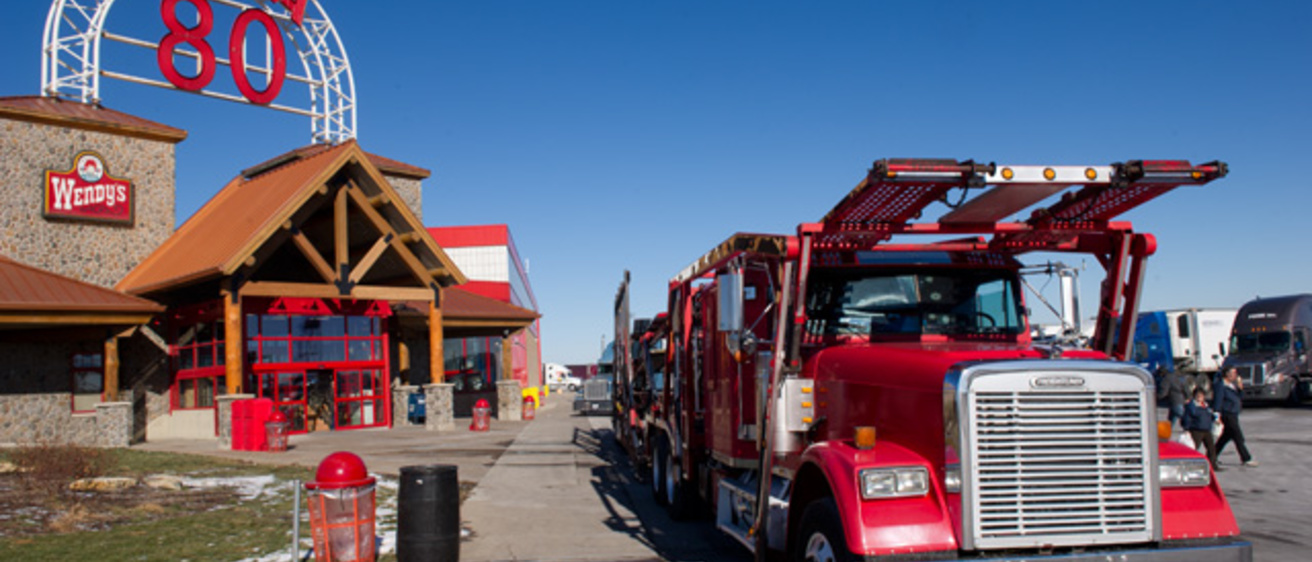A common question that people ask Delia Moon Meier about The World’s Largest Truck Stop is, is it really the world’s largest truck stop?
Meier, who owns the business with her brother Will, admits she doesn’t know. It started when Standard Oil named it the World’s Largest Amoco in the 1980s, and over time that kind of morphed into The World’s Largest Truck Stop. The claim hasn’t been tested, she says, though it isn’t for lack of trying.
“I’m trying to get Guinness to verify it, but they’re not receptive,” says Meier. “I keep arguing with them, but they say they wouldn’t know how to measure it. But nobody’s told us we aren’t.”
Formally known as the Iowa 80 Truck Stop, The World’s Largest is one of the state’s eastern gateways on Interstate 80, dominating the truck stop-heavy exit 284 at Walcott. It draws 64 million customers a year, which is 20 times more than Iowa’s entire population. About 20 percent of them are long-haul commercial semi-truck drivers looking for a place to eat, shower, wash some laundry and rent a video while laying up for the night in their sleeper cabs in the parking lot.

A fair number of customers are also no doubt UI students and alumni, which is fine with Meier and Moon because they’re both graduates* of the Tippie College of Business.** For students and alumni coming from the east—which includes the huge contingent from Chicagoland—the truck stop is a marker that says you’re in the final stage of the drive to Iowa City. For some, it’s as much a part of their UI experience as Kinnick, Old Cap, and Carver Hawkeye.
*Will, Bachelor of Business Administration ’83; Delia, Bachelor of Business Administration ‘87
**The truck stop’s gift shop has a section of Hawkeye souvenirs. Cyclone stuff is conspicuously absent.
“I’ve had lots of students and alumni tell me that we’re their ‘almost home,’ that when they see our lights, they know they’re getting close,” says Meier.
And it’s hard not to see its lights because they’re visible from miles away, and its giant “World’s Largest Truck Stop” sign, anchored in 1.3 million pounds of concrete, blazes blue. To call Iowa 80 a truck stop is like calling a Mack a golf cart. Meier and Moon say the place is meant as an homage to trucking because their father, Bill, Iowa 80’s founder, had such a strong affection for those who drive big rigs.
“He was never a trucker, but he loved the trucking culture, and the pride and mystique of being in this giant thing,” says Meier. “Who doesn’t grow up wanting to be a truck driver?”
“It’s a really hard life, but he knew how important trucking was to the economy and the country,” says Moon.
According to the American Trucking Association (ATA), the industry makes up about 5 percent of American GDP, and 70 percent of American freight tonnage moves at least partly on a truck. The ATA says trucks are the only commercial link to the outside world for 80 percent of U.S. communities.

“Trucking is a huge industry in the United States because that is how most things are moved from point to point,” says Ann Campbell, a professor of management sciences in the Tippie College who researches the trucking industry. “Even as more products are made in China and other countries, our need for trucking does not decline, as we need ways to move those things from the seaports to the distribution centers, stores, and homes.”
When opened in 1964 as a Standard station, the Iowa 80 Truck Stop was the first truck stop at the Walcott exit on a newly opened stretch of Interstate 80 that went no further west than Iowa City. Meier points to an old aerial photo from those early days, shot sometime during the day, and only two cars drive past on the freeway. Today, the road has so little traffic only sometime during the middle of the night. But even in those early days, the station was bigger than most with a full-service restaurant and 10 fuel pumps.
“Ten pumps was considered huge back then,” says Moon.
As the interstate system grew, I-80 became the primary east-west thoroughfare in the central part of the country, eventually connecting San Francisco to Teaneck, N.J., a bridge-over-the-Hudson short of New York City. Traffic expanded, then exploded, and Campbell says the Iowa 80 Truck Stop was well-placed to take advantage of this growth.
“In Iowa, there are so many trucks on the road because of the all of the products that need to move from the West Coast to the East Coast and vice versa, so I-80 sees a lot of that traffic,” she says. “A lot more moves through Iowa than is made or consumed here because of our central location. Thus, the truck stop sees trucks coming and going to all over the United States.”

Trucking became an important part of American pop culture, too. Roger Miller’s King of the Roadwas a hit in 1965, just one year after Iowa 80 opened, and the Grateful Dead took a long, strange trip with Truckinin 1970. R Crumb’s iconic 1968 Keep on Truckin’illustration captured the coolness of trucking without showing either a truck or a trucker, but simply by using the word.
Trucking’s pop culture cache reached its peak in the 1970s. Hit movies like Cannonball Run and the Smokey and the Bandit prominently featured mischievously amiable semi-truck drivers, and Duel featured one not so amiable. CW McCall’s trucker anthem Convoygenerated massive radio airplay in 1975, turning “breaker, breaker” and “10-4, good buddy” into catchphrases and the CB radio into another one of those weird 1970s fads.
As trucking grew in prominence, the Iowa 80 grew along with it. Moon expanded the fuel stop and the restaurant, then added a maintenance bay to service semis in the 1970s, a gift shop in the 1980s, a food court in the 1990s.* They started a Trucker’s Jamboree in 1979, a three day festival every July that celebrates all things truck and attracts thousands of truckers and nontruckers alike.
*They expanded into Missouri and North Carolina, as well, and own truck wash and weighing facilities around the country.
Today, Iowa 80 has 85 developed acres with its own security staff, snow removal equipment and water wells. About 500 people work there, and over the decades it’s provided a lot of first jobs for high school kids in Walcott , Durant, Bennett, Davenport, and other nearby towns.
It has 24 showers and 130 toilets, where customers use an average of 55 miles of toilet paper every month. The stop serves 53 tons of beef every year, 58 tons of pork and more than 17 million eggs, and it pours 2 million cups of coffee. It offers an on-site barber, on-site chiropractor, on-site dentist* and on-site drug testing.** It has a truck wash and a dog wash. An embroidery shop stitches the names of truckers’ semis on hats, shirts and sweatshirts.***
*University of Iowa alumnus Dr. Tom Roemer, BS ‘84, DDS ‘88
**federal regulations require truck drivers to undergo random drug tests, and they have only a few hours from the time they’re notified to provide a sample.
***“Trucks are like boats, they’re all named,” says Moon.
And it has a trucking supply store that sells everything you need to drive a truck except the truck: cowboy boots, briefcases, air fresheners, copies of the U.S. Department of Transportation safety handbook, steering wheels with pink ribbons on the hub, air fresheners, rear axle covers that look like Cat in the Hat hats, horns that sound like train whistles and horns that go “ooooga,” which is what it actually says on the package, “ooooga.” An Oversize Load sign can be custom made for $299.99, which is well worth it even if you don’t own a semi because it would fun just to have an Oversize Load sign hanging on the wall. And so much chrome that if the sun hits it right, you need sunglasses to look at it.
Meier said the idea behind the truck stop is that it’s a home away from home for drivers, a place where truckers can take care of business that they’d rather not do when they finally get off the road. Nobody wants to spend their downtime shopping for air fresheners and mud flaps.
“We asked ourselves, what would we want if we can’t get home?” she says. “You want a clean shower, a desk to do your paperwork, a washing machine, someone to cut your hair. When they do get home, they want to spend their time with their family, not doing laundry.”
Meier and Moon also decided to fulfill their father’s final wish and in 2008 opened the Iowa 80 Trucking Museum. Bill Moon collected more than 80 trucks before he died in 1992, and Meier and Moon have continued building the collection. About half of their trucks are on display at the museum.

“Dad realized that trucks were an important part of American history and he hated to see them chopped up or crushed, and so he started collecting them,” says Meier.
For years, the trucks were kept in whatever storage Moon could find for them—barns garages, shelters—some of them restored, some still in the rusty, collapsing condition he bought them. The first truck Moon bought—sometime in the 1970s —was a 1919 International Harvester F-1 that sat in the family’s driveway for years and is now on display.
The oldest truck in the collection goes back to 1910, a milk truck from Chicago that was run on electric batteries. Moon points out it went 40 miles on a charge, which is the same mileage the Chevy Volt gets today, a century later.
The collection also features what was for a time the world’s fastest semi-truck, a Kenworth owned by Muscatine’s Martin Carver* that set the land speed record for a truck at 150.918 mph on the Bonneville Salt Flats in 1988.
*of the family whose name is featured prominently across the University of Iowa campus
The collection also features an experimental truck called the Paymaster that offered an alternative to conventional truck design that proved to be a failure. Rather than the typical look of a semi—either a snout-nosed engine compartment thrust out in front of a driver’s cab, a design that has been largely unchanged since the 1940s, or the flat front design that came later—this one has, among other unique attributes, a sloped hood that drops sharply from the cab so that it look more like a street sweeper. Meier says it was designed by an inventor/truck driver in the late 1960s and Ryder trucks purchased the design and five were actually produced in 1974 in the company’s livery.
The design, predictably, went nowhere.
“No self-respecting truck driver would be caught dead in that thing,” Meier says.
Admission to the museum—otherwise known as heaven to little boys—is free.
